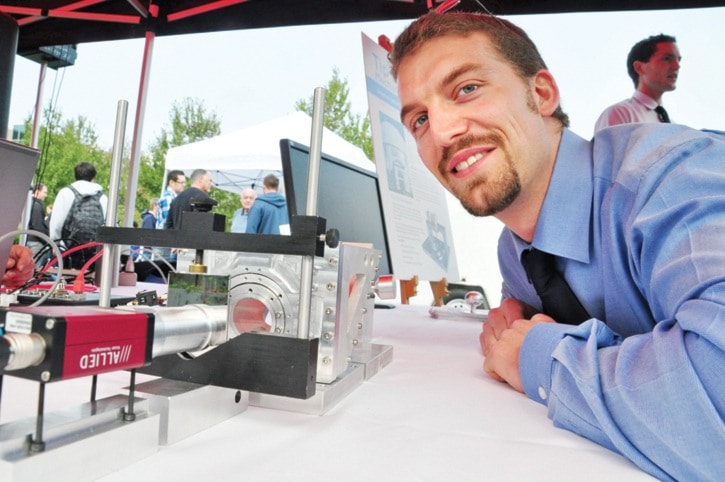Earlier this year, companies and high-tech government agencies collaborated with Camosun College mechanical engineering students to solve difficult, real-world problems. Here are three of the projects students presented at the Interurban campus in late September.
Corrective lens for the Plaskett
The problem for any telescope stuck on Earth is the turbulent atmosphere. That’s no different for the region’s workhorse of astronomy, the Plaskett Telescope, now in its 94th year collecting light at the Dominion Astrophysical Observatory in Saanich.
A Camosun team developed a small stainless steel device that can tip and tilt an optical lens to correct the distortion of starlight travelling through the air.
Using what is called adaptive optics and sophisticated software to read distorted incoming light, the lens twists and turns almost as fast as the atmosphere changes.
“Light going through the atmosphere is distorted ... it’s the reason why stars twinkle,” said Foster Anderson, speaking for his engineering team. “We’ve created a star de-twinkler.”
The motor controls that rotate the lens are extraordinarily precise, and can nudge its round frame as little as 16 microns.
Remote tsunami sensing
In September, scientists and engineers from Neptune Canada, based at the University of Victoria, attempted to install a tsunami early-warning device off the west coast of Vancouver Island.
Attaching ultra-sensitive pressure sensors to 25-kilometre long fibre optic cables using a remotely operated vehicle (ROV) two kilometres below the surface proved to be tremendously difficult, and only partially successful.
A Camosun team updated the engineering to make the pressure sensor wireless and retrievable, for relatively easy placement on the sea floor, and easy repair or replacement if needed.
“The concept is to make the system less expensive to deploy,” said Gord Cooney, speaking for his team. “It can take an ROV 30 hours to lay a (fibre optic) cable, and the cable can break.”
The team adapted the pressure sensor for an acoustic modem, which sends data to a central hub already linked to the Neptune network. The modem can also trigger the release of the buoyant frame from the sea bed to shoot the pressure sensor to the surface.
Clean water on the fly
Construction projects in Victoria that dig into the ground often face the expensive task of removing dirty and contaminated water.
That can involve the expensive option of trucking it away or setting up an onsite decontamination plant. In partnership with Victoria’s Petro Barrier Systems, four Camosun students made an existing water filtration system mobile, about the size of a six by 10 foot trailer.
The mobile plant will be tested at the large City Centre project at Colwood Corners, which currently has a much larger system built by Petro Barrier.
“If you purify on site, the cost is about one-tenth the cost. It can be hugely expensive trucking it away,” said Anthony Richards, speaking for his team.
Richards said you probably wouldn’t want to drink the water filtered through the plant, but it does come out free of hydrocarbons, suspended solids and most other contaminants. “It’s not drinkable, but its clean potable water,” he said.
For Colwood Corners, a dry cleaning operation from the 1960s left areas soil saturated with dry-cleaning fluids, plus hydrocarbons from cars.
Petro Barrier owner Iain Muir said water coming out if his decontamination plant underwent daily, then weekly then monthly tests for cleanliness before it was flushed into the sewers.
editor@saanichnews.com
